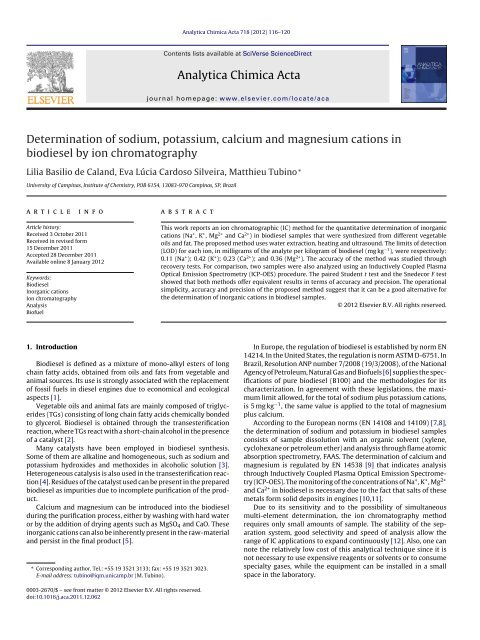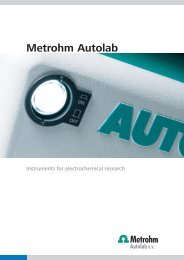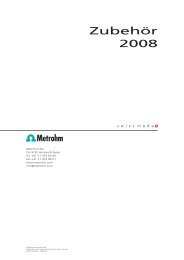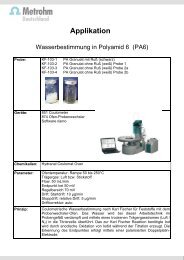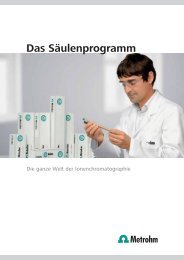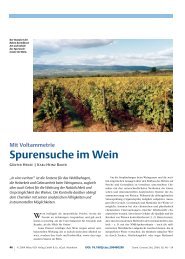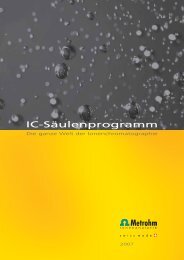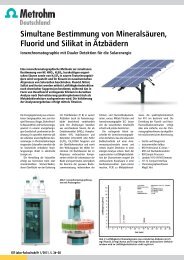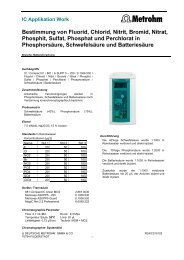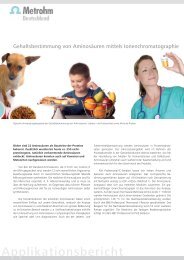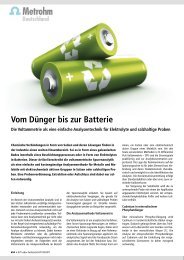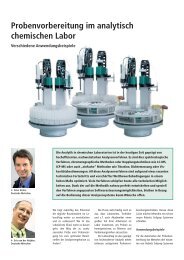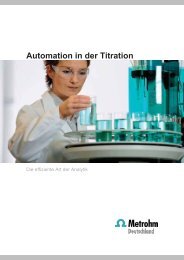Determination of sodium, potassium, calcium and magnesium ...
Determination of sodium, potassium, calcium and magnesium ...
Determination of sodium, potassium, calcium and magnesium ...
Create successful ePaper yourself
Turn your PDF publications into a flip-book with our unique Google optimized e-Paper software.
Analytica Chimica Acta 718 (2012) 116– 120<br />
Contents lists available at SciVerse ScienceDirect<br />
Analytica Chimica Acta<br />
jou rn al hom epa ge: www.elsevier.com/locate/aca<br />
<strong>Determination</strong> <strong>of</strong> <strong>sodium</strong>, <strong>potassium</strong>, <strong>calcium</strong> <strong>and</strong> <strong>magnesium</strong> cations in<br />
biodiesel by ion chromatography<br />
Lilia Basilio de Cal<strong>and</strong>, Eva Lúcia Cardoso Silveira, Matthieu Tubino ∗<br />
University <strong>of</strong> Campinas, Institute <strong>of</strong> Chemistry, POB 6154, 13083-970 Campinas, SP, Brazil<br />
a r t i c l e i n f o<br />
Article history:<br />
Received 3 October 2011<br />
Received in revised form<br />
15 December 2011<br />
Accepted 28 December 2011<br />
Available online 8 January 2012<br />
Keywords:<br />
Biodiesel<br />
Inorganic cations<br />
Ion chromatography<br />
Analysis<br />
Bi<strong>of</strong>uel<br />
1. Introduction<br />
a b s t r a c t<br />
Biodiesel is defined as a mixture <strong>of</strong> mono-alkyl esters <strong>of</strong> long<br />
chain fatty acids, obtained from oils <strong>and</strong> fats from vegetable <strong>and</strong><br />
animal sources. Its use is strongly associated with the replacement<br />
<strong>of</strong> fossil fuels in diesel engines due to economical <strong>and</strong> ecological<br />
aspects [1].<br />
Vegetable oils <strong>and</strong> animal fats are mainly composed <strong>of</strong> triglycerides<br />
(TGs) consisting <strong>of</strong> long chain fatty acids chemically bonded<br />
to glycerol. Biodiesel is obtained through the transesterification<br />
reaction, where TGs react with a short-chain alcohol in the presence<br />
<strong>of</strong> a catalyst [2].<br />
Many catalysts have been employed in biodiesel synthesis.<br />
Some <strong>of</strong> them are alkaline <strong>and</strong> homogeneous, such as <strong>sodium</strong> <strong>and</strong><br />
<strong>potassium</strong> hydroxides <strong>and</strong> methoxides in alcoholic solution [3].<br />
Heterogeneous catalysis is also used in the transesterification reaction<br />
[4]. Residues <strong>of</strong> the catalyst used can be present in the prepared<br />
biodiesel as impurities due to incomplete purification <strong>of</strong> the product.<br />
Calcium <strong>and</strong> <strong>magnesium</strong> can be introduced into the biodiesel<br />
during the purification process, either by washing with hard water<br />
or by the addition <strong>of</strong> drying agents such as MgSO 4 <strong>and</strong> CaO. These<br />
inorganic cations can also be inherently present in the raw-material<br />
<strong>and</strong> persist in the final product [5].<br />
∗ Corresponding author. Tel.: +55 19 3521 3133; fax: +55 19 3521 3023.<br />
E-mail address: tubino@iqm.unicamp.br (M. Tubino).<br />
0003-2670/$ – see front matter ©<br />
2012 Elsevier B.V. All rights reserved.<br />
doi:10.1016/j.aca.2011.12.062<br />
This work reports an ion chromatographic (IC) method for the quantitative determination <strong>of</strong> inorganic<br />
cations (Na + , K + , Mg 2+ <strong>and</strong> Ca 2+ ) in biodiesel samples that were synthesized from different vegetable<br />
oils <strong>and</strong> fat. The proposed method uses water extraction, heating <strong>and</strong> ultrasound. The limits <strong>of</strong> detection<br />
(LOD) for each ion, in milligrams <strong>of</strong> the analyte per kilogram <strong>of</strong> biodiesel (mg kg −1 ), were respectively:<br />
0.11 (Na + ); 0.42 (K + ); 0.23 (Ca 2+ ); <strong>and</strong> 0.36 (Mg 2+ ). The accuracy <strong>of</strong> the method was studied through<br />
recovery tests. For comparison, two samples were also analyzed using an Inductively Coupled Plasma<br />
Optical Emission Spectrometry (ICP-OES) procedure. The paired Student t test <strong>and</strong> the Snedecor F test<br />
showed that both methods <strong>of</strong>fer equivalent results in terms <strong>of</strong> accuracy <strong>and</strong> precision. The operational<br />
simplicity, accuracy <strong>and</strong> precision <strong>of</strong> the proposed method suggest that it can be a good alternative for<br />
the determination <strong>of</strong> inorganic cations in biodiesel samples.<br />
© 2012 Elsevier B.V. All rights reserved.<br />
In Europe, the regulation <strong>of</strong> biodiesel is established by norm EN<br />
14214. In the United States, the regulation is norm ASTM D-6751. In<br />
Brazil, Resolution ANP number 7/2008 (19/3/2008), <strong>of</strong> the National<br />
Agency <strong>of</strong> Petroleum, Natural Gas <strong>and</strong> Bi<strong>of</strong>uels [6] supplies the specifications<br />
<strong>of</strong> pure biodiesel (B100) <strong>and</strong> the methodologies for its<br />
characterization. In agreement with these legislations, the maximum<br />
limit allowed, for the total <strong>of</strong> <strong>sodium</strong> plus <strong>potassium</strong> cations,<br />
is 5 mg kg −1 , the same value is applied to the total <strong>of</strong> <strong>magnesium</strong><br />
plus <strong>calcium</strong>.<br />
According to the European norms (EN 14108 <strong>and</strong> 14109) [7,8],<br />
the determination <strong>of</strong> <strong>sodium</strong> <strong>and</strong> <strong>potassium</strong> in biodiesel samples<br />
consists <strong>of</strong> sample dissolution with an organic solvent (xylene,<br />
cyclohexane or petroleum ether) <strong>and</strong> analysis through flame atomic<br />
absorption spectrometry, FAAS. The determination <strong>of</strong> <strong>calcium</strong> <strong>and</strong><br />
<strong>magnesium</strong> is regulated by EN 14538 [9] that indicates analysis<br />
through Inductively Coupled Plasma Optical Emission Spectrometry<br />
(ICP-OES). The monitoring <strong>of</strong> the concentrations <strong>of</strong> Na + , K + , Mg 2+<br />
<strong>and</strong> Ca 2+ in biodiesel is necessary due to the fact that salts <strong>of</strong> these<br />
metals form solid deposits in engines [10,11].<br />
Due to its sensitivity <strong>and</strong> to the possibility <strong>of</strong> simultaneous<br />
multi-element determination, the ion chromatography method<br />
requires only small amounts <strong>of</strong> sample. The stability <strong>of</strong> the separation<br />
system, good selectivity <strong>and</strong> speed <strong>of</strong> analysis allow the<br />
range <strong>of</strong> IC applications to exp<strong>and</strong> continuously [12]. Also, one can<br />
note the relatively low cost <strong>of</strong> this analytical technique since it is<br />
not necessary to use expensive reagents or solvents or to consume<br />
specialty gases, while the equipment can be installed in a small<br />
space in the laboratory.
The technique <strong>of</strong> ion chromatography is nowadays widely used<br />
in analysis <strong>of</strong> biological [12–14] <strong>and</strong> environmental [15] samples,<br />
oil products [16] <strong>and</strong> water [17–20] for the simultaneous determination<br />
<strong>of</strong> ions, particularly at the level <strong>of</strong> trace concentrations.<br />
There are a few cases where this technique was explored for the<br />
analysis <strong>of</strong> biodiesel for the determination <strong>of</strong> metallic ions [21,22]<br />
but, as far we know, no full detailed papers using this technique are<br />
reported in the literature.<br />
In this study an ion chromatographic (IC) method for simultaneous<br />
determination <strong>of</strong> Na + , K + , Mg 2+ <strong>and</strong> Ca 2+ in samples <strong>of</strong> biodiesel<br />
is developed. The ions are extracted from the matrix using water,<br />
heating <strong>and</strong> ultrasound. The detection is done using conductimetry.<br />
The proposed extraction procedure <strong>of</strong> the ions from the sample<br />
is very attractive because the use <strong>of</strong> organic solvents is avoided.<br />
2. Experimental<br />
2.1. Materials <strong>and</strong> methods<br />
2.1.1. Reagents <strong>and</strong> solutions<br />
All reagents were <strong>of</strong> analytical grade. The aqueous solutions<br />
were prepared with deionized water, ultrapure Type I<br />
(18.2 M cm), obtained from a Milli-Q system (Millipore, Bedford,<br />
MA, USA).<br />
St<strong>and</strong>ard stock 1000 mg L −1 solutions <strong>of</strong> <strong>sodium</strong> <strong>and</strong> <strong>potassium</strong><br />
ions were prepared by weighing adequate masses <strong>of</strong> the respective<br />
anhydrous salts, NaCl <strong>and</strong> KCl, into distilled, deionized water.<br />
In the case <strong>of</strong> <strong>magnesium</strong> <strong>and</strong> <strong>calcium</strong>, stock solutions containing<br />
1000 mg L −1 were provided by Sigma–Aldrich (St. Louis, MO,<br />
USA). Mixed cation st<strong>and</strong>ard solutions <strong>of</strong> 1.00, 2.00, 3.00, 4.00, 5.00<br />
<strong>and</strong> 0.20, 0.40, 0.60, 0.80 <strong>and</strong> 1.00 mg L −1 were used to calibrate<br />
the ion chromatograph. All st<strong>and</strong>ards <strong>and</strong> samples were stored in<br />
polyethylene bottles.<br />
Recovery assays to test the extraction effectiveness from<br />
biodiesel were done using <strong>sodium</strong> cyclohexanebutyrate, <strong>potassium</strong><br />
cyclohexanebutyrate, <strong>calcium</strong> cyclohexanebutyrate <strong>and</strong> <strong>magnesium</strong><br />
cyclohexanebutyrate. Known amounts <strong>of</strong> the aforementioned<br />
salts were added to biodiesel samples, then submitted to the extraction<br />
procedure described in Section 2.3.<br />
2.1.2. Samples<br />
Vegetable oils <strong>and</strong> bovine fat were purchased in local shops.<br />
Seven samples <strong>of</strong> different types <strong>of</strong> biodiesel were used in this<br />
study. With the exception <strong>of</strong> the biodiesel from rough soy oil, which<br />
was fabricated <strong>and</strong> furnished by an industry, all were prepared in<br />
our laboratory [23]. Biodiesel prepared from sunflower oil was used<br />
to perform experimental tests in order to optimize the extraction<br />
process with ultrasound. The optimized process was then applied<br />
to seven other samples <strong>of</strong> biodiesel. Six <strong>of</strong> them were prepared<br />
from vegetable oils using the transesterification with methanol,<br />
i.e., for soy, rough soy, corn, sunflower <strong>and</strong> canola oils, <strong>and</strong> also<br />
through the transesterification with ethanol for canola oil. A seventh<br />
sample was prepared from animal fat (bovine) provided by a<br />
slaughterhouse, using the procedure with methanol.<br />
2.2. Extraction <strong>of</strong> the cations with aqueous solution<br />
Each sample was treated using ultrasound assisted extraction,<br />
in order to transfer the ions from biodiesel to an acidic aqueous<br />
solution. Aliquots (10 ± 0.001 g) were directly weighed into centrifuge<br />
tubes. 20 mL <strong>of</strong> deionized water <strong>and</strong> 50 �L <strong>of</strong> a 1.0 mol L −1<br />
HNO 3 aqueous solution (in order to maintain the pH <strong>of</strong> the samples<br />
at a suitable level for IC analyses) were added. The mixture was<br />
shaken for 1 min in a vortex apparatus (Motion II). Sequentially,<br />
the tube was partially immersed in a thermostatic bath set at 85 ◦ C<br />
for 30 min. The tube was then placed in an ultrasonic bath (Unique<br />
L.B. Cal<strong>and</strong> et al. / Analytica Chimica Acta 718 (2012) 116– 120 117<br />
Ultraclean 14000) operating at a frequency <strong>of</strong> 50 kHz <strong>and</strong> sonication<br />
for 15 min. In sequence it was centrifuged at 1000 rpm for 5 min.<br />
The aqueous phase was separated <strong>and</strong> collected in a 25 mL volumetric<br />
flask <strong>and</strong> deionized water was added up to the mark. Before<br />
being injected into the chromatograph, aliquots from this solution<br />
were filtered through a 0.7 �m glass micr<strong>of</strong>iber filter.<br />
2.3. Instruments<br />
Analyses were conducted using an ion chromatograph equipped<br />
with a conductivity detector (Metrohm model 761), a dialysis system<br />
<strong>and</strong> a 100 �L injection loop. A cation exchange column with<br />
carboxylic groups on silica gel, model Metrosep C4 100, with 7 �m<br />
particles, was used. Its dimensions were: 100 mm length <strong>and</strong> 4 mm<br />
internal diameter.<br />
In this work an optimization <strong>of</strong> the eluent solutions aiming<br />
was carried out to obtain better chromatographic separation <strong>of</strong> the<br />
studied cations. Two eluent solutions were employed (oxalic acid;<br />
nitric/dipicolinic acid) in various concentrations. It was observed,<br />
based on the investigated chromatographic parameters, that the<br />
eluent dipicolinic/nitric acid at 1.7 mmol L −1 (dipicolinic acid) <strong>and</strong><br />
2.5 mmol L −1 (nitric acid) enabled a shorter analysis time <strong>and</strong> quite<br />
satisfactory separation <strong>of</strong> the cations. Therefore, this solution was<br />
employed, at a flow rate <strong>of</strong> 0.9 mL min −1 . The eluent was always<br />
previously degassed with ultrasonication for 15 min.<br />
For comparison purposes samples <strong>of</strong> sunflower oil <strong>and</strong> bovine<br />
fat biodiesels were also analyzed using ICP-OES (PerkinElmer,<br />
Norwalk, EUA). The following spectral lines were used: <strong>sodium</strong><br />
588.995 nm; <strong>potassium</strong> 766.490 nm; <strong>magnesium</strong> 280.271 nm <strong>and</strong><br />
<strong>calcium</strong> 317.933 nm.<br />
3. Results <strong>and</strong> discussion<br />
3.1. The analytical method<br />
The determination <strong>of</strong> Na + , K + , Mg 2+ <strong>and</strong> Ca 2+ in biodiesel is<br />
<strong>of</strong> importance as their presence results in solid deposits inside<br />
engines. However, as they usually are present in low concentrations<br />
in a matrix as complex as biodiesel, the analytical procedures<br />
are not trivial.<br />
The results obtained in this work demonstrate that it is possible<br />
to simultaneously analyze these alkaline <strong>and</strong> alkaline-earth cations<br />
using ion chromatography. The ions were initially extracted using<br />
water as extracting solvent, in the presence <strong>of</strong> acid, with the aid <strong>of</strong><br />
heating <strong>and</strong> ultrasound. This extraction employs the higher affinity<br />
<strong>of</strong> the inorganic cations for a highly polar solvent such as water, in<br />
comparison to a non-polar organic solvent (biodiesel).<br />
The literature describes different optimum ultrasonic exposition<br />
times, varying from 5 to 180 min, in order to achieve complete<br />
extraction for different samples [24]. To verify the efficiency <strong>of</strong><br />
the ultrasound extraction, known amounts <strong>of</strong> each analyte were<br />
separately added to sunflower biodiesel samples <strong>and</strong> exposed to<br />
ultrasound during different times, from 0 to 30 min.<br />
The results are shown in Fig. 1 where it can be observed<br />
that larger samples amounts (10 g) <strong>and</strong> longer ultrasound assisted<br />
extractions were beneficial to the recovery yields. The application<br />
<strong>of</strong> ultrasound for 10 min (Na + , K + <strong>and</strong> Ca 2+ ) <strong>and</strong> 15 min (Mg 2+ )<br />
ensures good recoveries. Aiming to analyze simultaneously these<br />
four metals, 15 min <strong>of</strong> sonication was employed. A decrease in the<br />
recovery <strong>of</strong> Mg 2+ was observed beyond ca. 15 min <strong>of</strong> sonication.<br />
According to Souza et al. [25] this decreasing could indicate the<br />
formation <strong>of</strong> non-soluble species, reducing the analyte concentration<br />
in the solution. However, it is difficult to imagine what kind <strong>of</strong><br />
insoluble species could be formed in the presence <strong>of</strong> HNO 3 <strong>and</strong> in<br />
such low concentrations.
118 L.B. Cal<strong>and</strong> et al. / Analytica Chimica Acta 718 (2012) 116– 120<br />
Fig. 1. Recovery (%) from a sunflower biodiesel containing (2.00 ± 0.01) mg L −1 <strong>of</strong> each cation after different ultrasound treatments with two biodiesel amounts 5 g (•) <strong>and</strong><br />
10 g (�).<br />
If we consider the data exposed in Fig. 1 <strong>and</strong> calculate the overall<br />
mean (among the extraction values from 0 to 30 min) <strong>of</strong> the extraction<br />
recovery for 10 g <strong>of</strong> biodiesel, the value for <strong>sodium</strong>, whose salts<br />
are very soluble, is equivalent to that <strong>of</strong> <strong>magnesium</strong>, indicating that<br />
other phenomena are probably affecting the process. Sodium <strong>and</strong><br />
<strong>magnesium</strong> are neighbors in the third row <strong>of</strong> the periodic table <strong>and</strong><br />
<strong>potassium</strong> <strong>and</strong> <strong>calcium</strong> are neighbors in the fourth row. Curiously,<br />
the extraction recoveries can be placed in “pairs” as functions <strong>of</strong><br />
their mean atomic masses, i.e.,: Na + , 87.7% <strong>and</strong> 23.0; Mg 2+ , 86.4%<br />
<strong>and</strong> 24.3; K + , 96.8% <strong>and</strong> 39.1; Ca 2+ , 100.3% <strong>and</strong> 40.1. This correlation<br />
indicates that there is some influence <strong>of</strong> the cation mass in the<br />
extraction process. Therefore, phenomena other than formation <strong>of</strong><br />
insoluble species are probably occurring as, for example, adsorption<br />
on the walls <strong>of</strong> the flask, among other possibilities. However,<br />
a detailed study is beyond the aim <strong>of</strong> the present work.<br />
3.2. Concentrations <strong>of</strong> the Na + , K + , Mg 2+ <strong>and</strong> Ca 2+ ions in the<br />
aqueous extract<br />
Fig. 2 shows an ion chromatogram obtained in the analysis <strong>of</strong><br />
a biodiesel from soy oil where the signals <strong>of</strong> <strong>sodium</strong>, <strong>potassium</strong>,<br />
<strong>magnesium</strong> <strong>and</strong> <strong>calcium</strong> ions are clearly shown. Table 1 reports<br />
the retention times, the analytical equations, <strong>and</strong> the detection <strong>and</strong><br />
quantitation limits.<br />
Table 2 also shows the figures <strong>of</strong> merit for the determination <strong>of</strong><br />
Na + , K + , Ca 2+ <strong>and</strong> Mg 2+ in biodiesel by the proposed method, after<br />
ultrasound assisted aqueous extraction.<br />
The linearities <strong>of</strong> the analytical curves are quite satisfactory as<br />
the coefficient <strong>of</strong> determination, R 2 ≥ 0.994. The limits <strong>of</strong> detection<br />
(LOD) <strong>and</strong> limits <strong>of</strong> quantitation (LOQ) obtained are adequate for<br />
the analysis <strong>of</strong> these cations in biodiesel as they are lower than<br />
the highest concentrations allowed by the norms, i.e., 5 mg kg −1<br />
for <strong>sodium</strong> plus <strong>potassium</strong> <strong>and</strong> also for <strong>magnesium</strong> plus <strong>calcium</strong>,<br />
(Brazil, ANP resolution n. 07/2008; <strong>and</strong> by the fuel legislations <strong>of</strong><br />
Fig. 2. Chromatogram obtained in the analysis <strong>of</strong> biodiesel from soy oil containing<br />
<strong>sodium</strong>, <strong>potassium</strong>, <strong>magnesium</strong> <strong>and</strong> <strong>calcium</strong> ions.
Table 1<br />
Analytical curves (A = a + bC) a ; coefficient <strong>of</strong> determination, R 2 ≥ 0.994); limits <strong>of</strong><br />
detection (LOD in mg kg −1 ) <strong>and</strong> limits <strong>of</strong> quantitation (LOQ in mg kg −1 ) for the<br />
analysis <strong>of</strong> Na + , K + , Ca 2+ <strong>and</strong> Mg 2+ in biodiesels through ion chromatography.<br />
Na + K + Ca 2+ Mg 2+<br />
Retention time<br />
(min)<br />
2.99 4.00 5.34 7.00<br />
a −1.10 ± 1.82 −1.58 ± 4.71 1.11 ± 3.46 7.6 ± 12.4<br />
b 53.8 ± 1.8 37.3 ± 1.4 48.7 ± 1.0 114.4 ± 3.7<br />
sb 1.82 4.71 3.46 12.4<br />
LODb 0.11 0.42 0.23 0.36<br />
LOQc 0.33 1.25 0.70 1.07<br />
a A = Area, in (�S cm−1 ) min; a = linear coefficient; b = slope; C = concentration in<br />
mg kg−1 .<br />
b LOD = 3.3 s/b, where s is the st<strong>and</strong>ard deviation <strong>of</strong> the linear coefficient <strong>and</strong> b is<br />
the slope <strong>of</strong> the analytical curve.<br />
c LOD = 10 s/b [27].<br />
USA, EU <strong>and</strong> Australia). Similar limits <strong>of</strong> determination <strong>and</strong> <strong>of</strong> quantitation<br />
were obtained by Piovezan et al. [26] using liquid–liquid<br />
extraction <strong>and</strong> capillary electrophoresis for the quantitative analysis<br />
<strong>of</strong> such cations.<br />
In order to verify the efficiency <strong>of</strong> the extraction process used,<br />
tests were performed by adding known quantities <strong>of</strong> these four<br />
cations to a biodiesel prepared from sunflower oil. Extraction was<br />
done as described. The results are shown in Table 2.<br />
The sample <strong>of</strong> biodiesel from sunflower oil presented recoveries<br />
between minimums <strong>of</strong> 90.6% (Mg 2+ ) <strong>and</strong> maximums <strong>of</strong> 108.2% (K + ),<br />
with 15 min <strong>of</strong> sonication, indicating that the extraction procedure<br />
used was sufficiently efficient to remove the cations present in the<br />
mixture <strong>of</strong> the long chain alkyl esters.<br />
L.B. Cal<strong>and</strong> et al. / Analytica Chimica Acta 718 (2012) 116– 120 119<br />
Currently, in analytical procedures, recovery percentages in the<br />
range from 70 to 120%, with precision <strong>of</strong> about 20%, are accepted.<br />
However, depending on matrix complexity, this range can be<br />
extended from 50% to 120% with precision <strong>of</strong> 15% [27]. Considering<br />
the extraction efficiency obtained in this work, the proposed<br />
method presents accuracy sufficient to be applied for the determination<br />
<strong>of</strong> the four metallic cations analyzed in biodiesel samples.<br />
With respect to the precision obtained it also can be considered<br />
sufficient.<br />
3.3. Statistical comparison <strong>of</strong> the proposed method with ICP-OES<br />
The accuracy <strong>of</strong> the method was determined through recovery<br />
experiments performed with a biodiesel prepared from sunflower<br />
oil. The aqueous extract was analyzed with the method proposed<br />
herein. The IC results were compared with those obtained with<br />
the ICP-OES procedure. In these experiments known quantities <strong>of</strong><br />
an organic salt <strong>of</strong> each cation studied were directly added to the<br />
biodiesel.<br />
With the objective to demonstrate the equivalence, in terms <strong>of</strong><br />
accuracy <strong>and</strong> precision <strong>of</strong> the proposed method with ICP-OES, analyses<br />
were performed using the two procedures for the same matrix.<br />
The statistical comparison was done using the paired Student-t test<br />
<strong>and</strong> the Snedecor F-test. The results can be seen in Table 3.<br />
The results shown in Table 3 indicate that for the sunflower <strong>and</strong><br />
for the bovine fat biodiesels analyzed, the equivalence between the<br />
two methods in terms <strong>of</strong> precision <strong>and</strong> accuracy is at the 95% confidence<br />
level. In the case <strong>of</strong> the soy biodiesel, equivalence <strong>of</strong> the<br />
precision at the 95% confidence level was observed for the four<br />
analytes. As for accuracy with the soy biodiesel, <strong>potassium</strong> agreed<br />
Table 2<br />
Results obtained with the recovery experiments <strong>of</strong> added analyte using ion chromatography with sunflower biodiesel as matrix. Extraction was performed with heating at<br />
85 ◦ C <strong>and</strong> 15 min <strong>of</strong> sonication.<br />
Cation Initial concentration a (mg kg −1 ) Added (mg kg −1 ) Found a (mg kg −1 ) Recovery (%)<br />
Na + 3.56 ± 0.05 1.148<br />
5.200<br />
K +
120 L.B. Cal<strong>and</strong> et al. / Analytica Chimica Acta 718 (2012) 116– 120<br />
Table 4<br />
Analysis <strong>of</strong> various biodiesels using the proposed method <strong>and</strong> the analytical equations reported in Table 1.<br />
Na + (mg kg −1 ) RSD (%) K + (mg kg −1 ) RSD (%) Mg 2+ (mg kg −1 ) RSD (%) Ca 2+ (mg kg −1 ) RSD (%)<br />
Sunflower 3.56 ± 0.05 1.7 0.91 ± 0.13 14.7 0.13 ± 0.07 5.3 2.40 ± 0.08 3.3<br />
Corn 0.99 ± 0.06 6.1 0.36 ± 0.06 16.6 0.06 ± 0.02 33.3 0.43 ± 0.08 18.6<br />
Soy 1.86 ± 0.25 13.4 0.35 ± 0.02 5.7 0.22 ± 0.05 22.7 1.13 ± 0.01 0.9<br />
Soy (crude) 0.92 ± 0.09 10.0 0.39 ± 0.03 7.8


